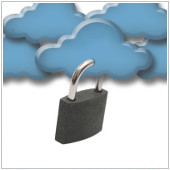 Cloud computing marketing can be deceiving. When you see an image of the cloud, it’s often a happy, bubbly white puffball floating delightfully in front of a blue sky background. Its presence is both calming and reassuring, and makes you believe that anything is possible. Security would never be an issue, right? Ask one of the nearly seven million Dropbox users who had their accounts hacked, and they’ll give you the definitive answer. While it’s worth noting that not every cloud provider has had security breaches like Dropbox, the point is to be aware that cloud security is not something to be taken lightly. Here’s what you can do to protect yourself as a business owner.
Cloud computing marketing can be deceiving. When you see an image of the cloud, it’s often a happy, bubbly white puffball floating delightfully in front of a blue sky background. Its presence is both calming and reassuring, and makes you believe that anything is possible. Security would never be an issue, right? Ask one of the nearly seven million Dropbox users who had their accounts hacked, and they’ll give you the definitive answer. While it’s worth noting that not every cloud provider has had security breaches like Dropbox, the point is to be aware that cloud security is not something to be taken lightly. Here’s what you can do to protect yourself as a business owner.
The cloud is playing more and more of a significant role in business. Yet, as more companies jump on the bandwagon, very few of them seem to be taking cloud security seriously. According to a recent survey, the “Security of Cloud Computing Users Study” , only 50 percent of those surveyed had investigated the security of the cloud services they used.
To ensure you put in place proper security measures when beginning your cloud venture, here are five actions every small business owner should take.
Ask your IT provider what cloud security policies they have in place – this is probably the single most important security measure you can take. Find a trusted IT provider and have a candid conversation with them about their cloud security policies.
Ask where the location of the physical cloud servers are – when you have “the conversation”, don’t forget to ask about this. Believe it or not, some cloud servers may not even be stored in your own country. Wherever they are, it’s wise to make sure they’re located in a safe data center area with proper security afforded to them.
Create unique usernames and passwords – your login credentials represent one of the cloud’s main security vulnerabilities. Take the time to come up with a better password than “12345” or “football.”
Use industry standard encryption and authentication protocols – IPsec (Internet Protocol Security) is a reliable technology choice.
Encrypt data before it’s uploaded to the cloud – whether you do it yourself or your cloud computing provider does it for you, this is a must to ensure security.
When it comes to trusting the security of a cloud service provider, transparency is key. The provider should take security seriously, be able to explain their security policies clearly, and be willing to answer any questions. If they can’t do one of these, it’s a clear sign of a red flag.
Are you ready to talk cloud security and transition your business into the cloud? Call us today. We’re happy to answer all your questions.